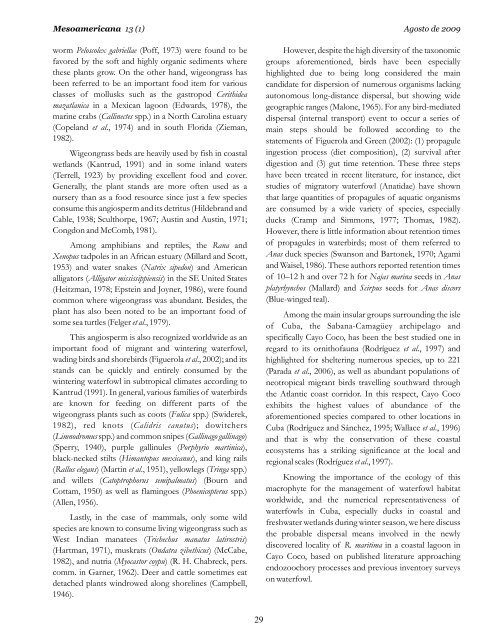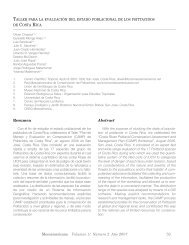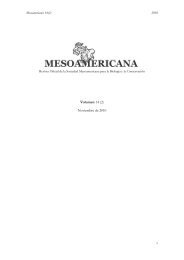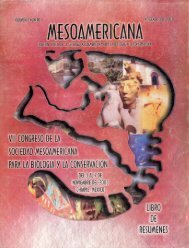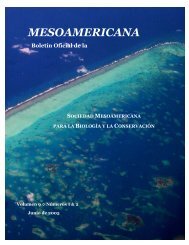MESOAMERICANA - Sociedad Mesoamericana para la BiologÃa y la ...
MESOAMERICANA - Sociedad Mesoamericana para la BiologÃa y la ...
MESOAMERICANA - Sociedad Mesoamericana para la BiologÃa y la ...
Create successful ePaper yourself
Turn your PDF publications into a flip-book with our unique Google optimized e-Paper software.
<strong>Mesoamericana</strong> 13 (1) Agosto de 2009<br />
worm Peloscolex gabriel<strong>la</strong>e (Poff, 1973) were found to be<br />
favored by the soft and highly organic sediments where<br />
these p<strong>la</strong>nts grow. On the other hand, wigeongrass has<br />
been referred to be an important food item for various<br />
c<strong>la</strong>sses of mollusks such as the gastropod Cerithidea<br />
mazat<strong>la</strong>nica in a Mexican <strong>la</strong>goon (Edwards, 1978), the<br />
marine crabs (Callinectes spp.) in a North Carolina estuary<br />
(Cope<strong>la</strong>nd et al., 1974) and in south Florida (Zieman,<br />
1982).<br />
Wigeongrass beds are heavily used by fish in coastal<br />
wet<strong>la</strong>nds (Kantrud, 1991) and in some in<strong>la</strong>nd waters<br />
(Terrell, 1923) by providing excellent food and cover.<br />
Generally, the p<strong>la</strong>nt stands are more often used as a<br />
nursery than as a food resource since just a few species<br />
consume this angiosperm and its detritus (Hildebrand and<br />
Cable, 1938; Sculthorpe, 1967; Austin and Austin, 1971;<br />
Congdon and McComb, 1981).<br />
Among amphibians and reptiles, the Rana and<br />
Xenopus tadpoles in an African estuary (Mil<strong>la</strong>rd and Scott,<br />
1953) and water snakes (Natrix sipedon) and American<br />
alligators (Alligator mississippiensis) in the SE United States<br />
(Heitzman, 1978; Epstein and Joyner, 1986), were found<br />
common where wigeongrass was abundant. Besides, the<br />
p<strong>la</strong>nt has also been noted to be an important food of<br />
some sea turtles (Felger et al., 1979).<br />
This angiosperm is also recognized worldwide as an<br />
important food of migrant and wintering waterfowl,<br />
wading birds and shorebirds (Figuero<strong>la</strong> et al., 2002); and its<br />
stands can be quickly and entirely consumed by the<br />
wintering waterfowl in subtropical climates according to<br />
Kantrud (1991). In general, various families of waterbirds<br />
are known for feeding on different parts of the<br />
wigeongrass p<strong>la</strong>nts such as coots (Fulica spp.) (Swiderek,<br />
1982), red knots (Calidris canutus); dowitchers<br />
(Limnodromus spp.) and common snipes (Gallinago gallinago)<br />
(Sperry, 1940), purple gallinules (Porphyrio martinica),<br />
b<strong>la</strong>ck-necked stilts (Himantopus mexicanus), and king rails<br />
(Rallus elegans) (Martin et al., 1951), yellowlegs (Tringa spp.)<br />
and willets (Catoptrophorus semipalmatus) (Bourn and<br />
Cottam, 1950) as well as f<strong>la</strong>mingoes (Phoenicopterus spp.)<br />
(Allen, 1956).<br />
Lastly, in the case of mammals, only some wild<br />
species are known to consume living wigeongrass such as<br />
West Indian manatees (Trichechus manatus <strong>la</strong>tirostris)<br />
(Hartman, 1971), muskrats (Ondatra zibethicus) (McCabe,<br />
1982), and nutria (Myocastor coypu) (R. H. Chabreck, pers.<br />
comm. in Garner, 1962). Deer and cattle sometimes eat<br />
detached p<strong>la</strong>nts windrowed along shorelines (Campbell,<br />
1946).<br />
29<br />
However, despite the high diversity of the taxonomic<br />
groups aforementioned, birds have been especially<br />
highlighted due to being long considered the main<br />
candidate for dispersion of numerous organisms <strong>la</strong>cking<br />
autonomous long-distance dispersal, but showing wide<br />
geographic ranges (Malone, 1965). For any bird-mediated<br />
dispersal (internal transport) event to occur a series of<br />
main steps should be followed according to the<br />
statements of Figuero<strong>la</strong> and Green (2002): (1) propagule<br />
ingestion process (diet composition), (2) survival after<br />
digestion and (3) gut time retention. These three steps<br />
have been treated in recent literature, for instance, diet<br />
studies of migratory waterfowl (Anatidae) have shown<br />
that <strong>la</strong>rge quantities of propagules of aquatic organisms<br />
are consumed by a wide variety of species, especially<br />
ducks (Cramp and Simmons, 1977; Thomas, 1982).<br />
However, there is little information about retention times<br />
of propagules in waterbirds; most of them referred to<br />
Anas duck species (Swanson and Bartonek, 1970; Agami<br />
and Waisel, 1986). These authors reported retention times<br />
of 10–12 h and over 72 h for Najas marina seeds in Anas<br />
p<strong>la</strong>tyrhynchos (Mal<strong>la</strong>rd) and Scirpus seeds for Anas discors<br />
(Blue-winged teal).<br />
Among the main insu<strong>la</strong>r groups surrounding the isle<br />
of Cuba, the Sabana-Camagüey archipe<strong>la</strong>go and<br />
specifically Cayo Coco, has been the best studied one in<br />
regard to its ornithofauna (Rodríguez et al., 1997) and<br />
highlighted for sheltering numerous species, up to 221<br />
(Parada et al., 2006), as well as abundant popu<strong>la</strong>tions of<br />
neotropical migrant birds travelling southward through<br />
the At<strong>la</strong>ntic coast corridor. In this respect, Cayo Coco<br />
exhibits the highest values of abundance of the<br />
aforementioned species compared to other locations in<br />
Cuba (Rodríguez and Sánchez, 1995; Wal<strong>la</strong>ce et al., 1996)<br />
and that is why the conservation of these coastal<br />
ecosystems has a striking significance at the local and<br />
regional scales (Rodríguez et al., 1997).<br />
Knowing the importance of the ecology of this<br />
macrophyte for the management of waterfowl habitat<br />
worldwide, and the numerical representativeness of<br />
waterfowls in Cuba, especially ducks in coastal and<br />
freshwater wet<strong>la</strong>nds during winter season, we here discuss<br />
the probable dispersal means involved in the newly<br />
discovered locality of R. maritima in a coastal <strong>la</strong>goon in<br />
Cayo Coco, based on published literature approaching<br />
endozoochory processes and previous inventory surveys<br />
on waterfowl.


